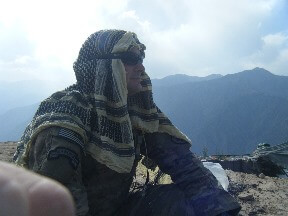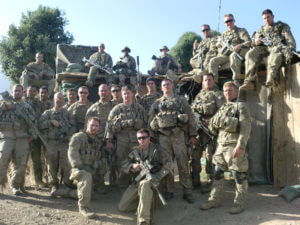Mission
WW.care’s mission is to create a new PTSD cure which is ten times better, faster, and cheaper than existing treatments. This breakthrough cure will be highly scalable so that it benefits millions of people every year whose lives are ravaged by PTSD. #curePTSD
Where Your Donations Go
We invest your donations into researching new methods of curing PTSD, and clinical trials to prove their efficacy. Of every dollar we receive, 88 cents goes to treatment and research programs. Fundraising and administration take 12 cents. And before we even receive a dollar, Visa and Mastercard take their 3 cents.
Our immediate plans are a Phase 1 clinical trial of TLT, Transcranial Laser Therapy in 40 Wounded Warriors. TLT is a very promising new therapy which has been shown in a pilot study to have efficacy of up to 100% in patients with PTSD, Post Traumatic Stress Disorder, and TBI, Traumatic Brain Injury.
Clinical trials are very costly. The first clinical trial for TLT, Transcranial Laser Therapy, will cost $10-15 thousand dollars per participant. As clinical trials expand the number of participants and start including multiple researchers at universities, the costs could reach $30-100 thousand dollars per participant. Even though the ultimate TLT treatment could cost just a few thousand dollars per person, the research required is progressively more expensive.
We are planning at least three sequential small Phase 1 trials of TLT to determine the fastest and best dose and timing to achieve PTSD cures. At the same time, we will investigate the use of TLT combined with other scalable treatments including EMDR and/or MDMA, and conduct at least one Phase 1 trial of combined therapy. Based on those results, we will proceed to a larger Phase 2 trial. These trials will cost in excess of 5 million dollars.
Charity Info
Real Care for Wounded Warriors Inc., is a registered non-profit, 501(C)3 charitable organization. Your donations are highly appreciated, and tax-deductible. There are many organizations dedicated to helping Wounded Warriors, and many dedicated to PTSD. We are not associated with the Wounded Warrior Project (NY), which is often in the news.
Some charities “give a hungry person a fish to eat” by giving away food, shelter, medicine, and clothing, and that’s very helpful to meet short-term needs. They focus on helping one person at a time. Some charities “teach a hungry person to fish” by teaching them new skills, helping them get a job, or giving them medical treatment, and that’s an even more powerful way to help. They focus on helping dozens, or hundreds, of people at a time. Some charities “invent a better way to fish” and create more efficient solutions that dramatically benefit millions of people.
WW.care “teaches a hungry person to fish” by treating Wounded Warriors with new treatments which are designed to cure PTSD, not just temporarily treat the symptoms. Our treatments are part of our research efforts to “invent a better way to fish” by developing breakthrough, scalable PTSD cures. With your generous help, we’ll truly change the lives of 8 million Americans.
The Scope of the PTSD Epidemic
Post Traumatic Stress Disorder, PTSD, is a global problem affecting tens of millions of people. In the US alone, this epidemic affects 8 million people each year. Among civilians, it is more common among women, primarily as a result of sexual trauma and various types of abuse. Among men, accidents play a larger role.
Our Wounded Warriors are most afflicted, with some estimates as high as 35% of the troops who were deployed to combat zones. PTSD frequently causes severe depressions, continual nightmares, and hypervigilance. As protection, many PTSD victims withdraw from social interactions so as to avoid triggers. Family, friends, and employment all suffer. Ultimately, suicide may result.
Although the Department of Defense spends four billion dollars per year on PTSD, it has little to show for it. There are no breakthrough treatments, and the government is generally resistant to novel treatment approaches. Recently, the first study of marijuana in PTSD was approved after six years of delay. The “best” PTSD treatments today average a 50% cure rate, are available to only a small fraction of PTSD victims, and take many weeks or months. Drugs are a band-aid, not a cure.
Even after tens of billions of dollars of spending on PTSD, Wounded Warriors are committing suicide at the rate of 22 per day, or more. That’s 8,000 per year. Every soldier has a higher chance of committing suicide from PTSD upon their return than they do of being killed in action. With your help, we can give back to our Wounded Warriors, rather than making them suffer every day.
Staff
Pat Dane, Chief Development Officer
Letter From Pat:
 I started Wounded Warrior Care because of my son, Matt’s, experience with PTSD and suicide.
I started Wounded Warrior Care because of my son, Matt’s, experience with PTSD and suicide.In 2001, Matt joined the US Army. As a Team Leader in the Ranger’s Special Ops Unit, Matt was in the first wave of soldiers to parachute into Afghanistan. Later, Matt became a US Army Sniper. He’s seen four tours of duty and combat in Iraq and Afghanistan, and was awarded a Bronze Star in 2010.
 Matt and his soldiers have been targets of bullets, RPGs, IEDs, and mortars. Matt was wounded, along with hundreds of thousands of other Veterans. In 2013, Matt returned to civilian life and was able to successfully apply his management skills to new opportunities. Unfortunately, many of the soldiers that Matt supervised and worked with have been beaten down with PTSD at a rate higher than the 15% that the VA claims.
Matt and his soldiers have been targets of bullets, RPGs, IEDs, and mortars. Matt was wounded, along with hundreds of thousands of other Veterans. In 2013, Matt returned to civilian life and was able to successfully apply his management skills to new opportunities. Unfortunately, many of the soldiers that Matt supervised and worked with have been beaten down with PTSD at a rate higher than the 15% that the VA claims.

Matt has kept in close touch with the soldiers that he supervised and worked with as they returned from battlefield to civilian life. Over the past three years, Matt has seen four of his comrades succumb to suicide from PTSD. These brave soldiers escaped from combat and were able to return to their families, only to lose their lives to PTSD. For all of the VA’s efforts to treat PTSD, too often it fails.
When I found out about Dr. Kraft’s clinic and investigated their new treatment for PTSD, I showed it to Matt and we became very hopeful. Evidence of improvement in unemployment, sleep disturbances, and a reduction in suicidal thoughts are extremely encouraging. At last, there is new hope for a treatment that might really work, and work fast. I am committed to making sure that this new treatment, transcranial laser therapy, gets deployed to as many Veterans, as fast as possible.
— Pat Dane, Chief Development Officer
Dr. Harold Kraft, Principal Investigator
 Dr. Kraft graduated magna cum laude with an undergraduate degree in BioEngineering from University of Pennsylvania, and is a member of the prestigious Tau Beta Pi engineering society. He earned his M.D. from Georgetown University Medical School and then served as a resident, and as Chief Resident, in Anesthesiology at Georgetown University Hospital. Dr. Kraft spent two decades as a hospital-based anesthesiologist, serving as Chairman and Vice-Chairman of two community hospital departments. He is a Diplomate of the American Board of Anesthesiology, with a recent focus on non-invasive pain management.
Dr. Kraft graduated magna cum laude with an undergraduate degree in BioEngineering from University of Pennsylvania, and is a member of the prestigious Tau Beta Pi engineering society. He earned his M.D. from Georgetown University Medical School and then served as a resident, and as Chief Resident, in Anesthesiology at Georgetown University Hospital. Dr. Kraft spent two decades as a hospital-based anesthesiologist, serving as Chairman and Vice-Chairman of two community hospital departments. He is a Diplomate of the American Board of Anesthesiology, with a recent focus on non-invasive pain management.
Catalyzed by his engineering background, Dr. Kraft has had a parallel hi-tech career. During his residency, he published the first article on computers in automated anesthesia. Subsequently, he has founded and sold two software companies. He has been CEO and a C-level executive at several software companies, received two Red Herring awards, and filed numerous patents and patent applications.
Dr. Kraft is an Editor of the Psychology and Behavioral Science International Journal, and a member of the American Society for Lasers in Medicine and Surgery, the International Association for the Study of Pain, and the American Academy of Pain Management.